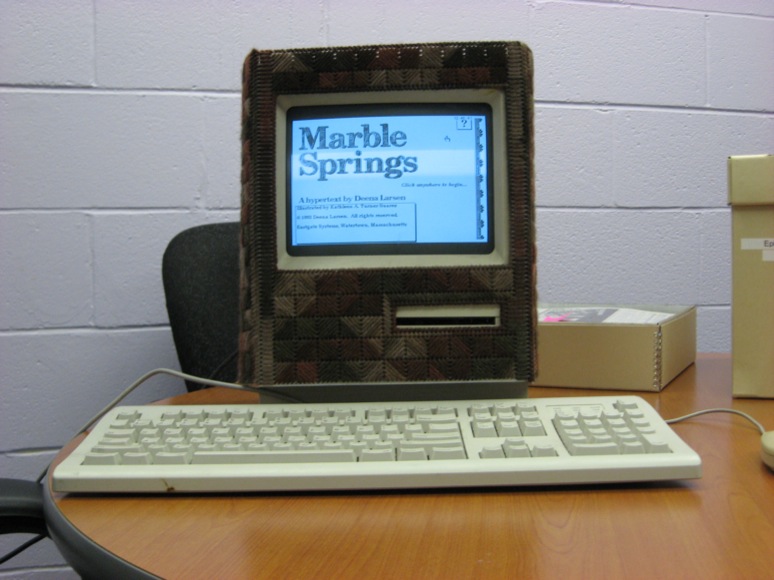As part of my final project: a website unbibliography, http://digitalliterature.net/bookhacking, providing a survey of readings on the idea of hacking the book: rewiring, reconsidering, and rebelling against the conventions of the traditional print codex, beginning with William Blake’s masterful Romantic productions. The readings cover the ways in which Blake hacked the book, how formats such as the Total Work of Art and artists’ books have further deformed the standard print tome, and how digital editions—particularly those electronically remediating Blake’s hacked books—themselves function as explosions of the conventions of the book. The readings pay particular attention to the visual design of books and online editions, treating graphical decisions as critical features of these texts and creating a catalog of opportunities and techniques for hacking the book.
Dissect and Rebuild: Reimagining Frankenstein as E-Lit
Posted by in Spring 2012 | Uncategorized - (4 Comments)For our group teaching tomorrow, Kristin Gray, Kathryn Skutlin, and I will begin class by demoing various forms of e-lit, followed by an e-lit exercise where you’ll re-imagine a pivotal scene of Frankenstein through the possibilities of e-lit (we’ll pass out handouts in class, but if you want a digital copy you can download this or see the assignment on my personal blog).
E-lit mentioned in class:
- Both Michael Joyce’s afternoon and Deena Larsen’s Marble Springs can be purchased from Eastgate Publishing. Or… make an appointment with MITH to read these and more e-lit on the original hardware, or visit the Deena Larsen Collection site to read more about Larsen’s work or watch a short video demo of Marble Springs.
- Larsen’s “Fun da mentals: Rhetorical Devices for Electronic Literature” is a fantastic site teaching basic approaches to writing e-lit.
- Caitlin Fisher’s These Waves of Girls is a 2001 Flash-based work.
- The Urban 30 is an example of a “fictional blog” based on WordPress (just like this site–well, the WordPress part!); in this case, multiple writers uses the blog community to write in as fictional characters. Urban 30 is particularly interesting because it tells a superhero story, a genre that was born and lived for a long time solely in comic books.
- The 21 Steps is a story told through Google Maps. Notice how this platform complements how important location is to the story.
- “Haircut” uses YouTube to create a choose-your-own-adventure video. If you’re curious how to do this, check out this tutorial on creating annotated YouTube videos.
- Stories created using texts and Twitter have taken off; “mobile phone novels” are especially popular in Japan, where this article claims they’ve “become so successful that they accounted for half of the ten best-selling novels in 2007.” This short article gives a sense of the kinds of stories people write via Twitter.
- In addition to individual-authored Twitter stories, large groups of strangers have used this platform for communal writing. The LA Flood Project was an event that encouraged Twitter users to tweet (with an #laflood hashtag) as if they were experiencing an apocalyptic flood in L.A. This page gives the brief timeline participants were supposed to follow; you can search Twitter for #laflood to see the story unfold, though it was most exciting in real-time (the latest tweets are just people rehashing the week-long event).
- And finally, the Electronic Literature Organization (ELO) hosts the Electronic Literature Collection 1 and Collection 2, which display a wide variety of approaches to electronic writing.
You might be interested in this essay by Jon Saklofske that evaluates the Blake Archive and imagines new ways of visualizing its content.
 Also: how do doppelgangers fit into our definition of the monstrous?
Also: how do doppelgangers fit into our definition of the monstrous?
I spent my bus ride home thinking about what it might mean to hack a book. I’ve seen beautiful sculptures made out of books (like these: one two three four) as well as more readable, but still fundamentally remixing acts of book hacking in the form of “altered books” like A Humument and Jonathan Safran Foer’s deliberately altered The Tree of Codes. Even more than book art, however, thinking about designing digital editions of paper books has helped me start noticing the individual mechanics of the vehicle, and it feels like outlining just what a book does is a good step toward making it do things it “shouldn’t” (i.e. hacking). Although we’re not talking about digital literature yet, it could be useful to contrast books on-screen and off if we want to start pointing to what makes a book work (or, you can check out this “Medieval Help Desk” video and think about the happy differences between scroll and book!).
Matt Kirschenbaum’s article “Bookscapes: Modeling Books in Electronic Space”* argues that contrasting books with their on-screen counterparts helps us call out the specific features important to the analog form because “books on the screen are not books, they are models of books”–and a model is made to be hacked and analyzed. Matt’s article offers a nice starting point for thinking about the features of books, identifying five affordances specific to the book:
- simultaneous random access and sequential ordering,
- volumetric (three-dimensional) storage space,
- finity/boundedness,
- the comparative possibilities offered by two facing pages (think of Folger student Shakespeare editions), and
- writeability (who hasn’t wished they could jot down notes on the PDF they’re reading online?).
As we look at how Blake hacks the book, can we add to Matt’s list of book affordances? In addition to broad characteristics, we might list specific elements such as the datedness of page numbering on the Nook or the (un?)necessary pause when “flipping” pages on a Kindle. Why were these technologies useful in books, and awkward (or nostalgic) in e-books?
*Kirschenbaum, Matthew. “Bookscapes: Modeling Books in Electronic Space”. Human-Computer Interaction Lab 25th Annual Symposium. May 29, 2008.


